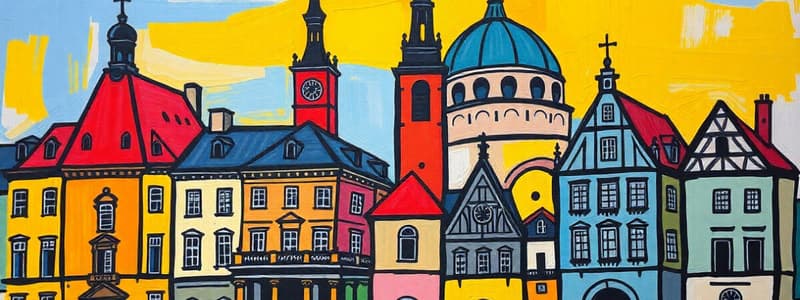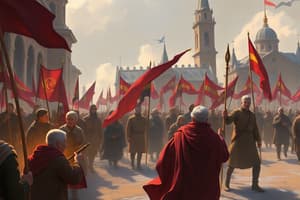Podcast
Questions and Answers
What is the architectural style of the Palace of Versailles?
What is the architectural style of the Palace of Versailles?
- Gothic
- Baroque (correct)
- Neoclassical
- Romanesque
Which monument is known for its unintended tilt?
Which monument is known for its unintended tilt?
- Eiffel Tower
- Leaning Tower of Pisa (correct)
- Sagrada Família
- Colosseum
Which of the following monuments was completed in AD 80?
Which of the following monuments was completed in AD 80?
- Brandenburg Gate
- Temple of Zeus
- Eiffel Tower
- Colosseum (correct)
What features characterized Gothic architecture?
What features characterized Gothic architecture?
Which site serves as a symbol of reunification in Germany?
Which site serves as a symbol of reunification in Germany?
What type of structure is the Sagrada Família?
What type of structure is the Sagrada Família?
Which monument is a UNESCO World Heritage site known for its Moorish architecture?
Which monument is a UNESCO World Heritage site known for its Moorish architecture?
What is a notable feature of the Rijksmuseum?
What is a notable feature of the Rijksmuseum?
Flashcards are hidden until you start studying
Study Notes
Monuments of Europe
1. Introduction to European Monuments
- Key cultural and historical symbols.
- Reflect diverse architectural styles and periods.
2. Notable Monuments by Country
-
France
- Eiffel Tower (Paris): Iconic iron lattice tower; built for the 1889 Exposition Universelle.
- Palace of Versailles: Baroque architecture; former royal residence and symbol of absolute monarchy.
-
Italy
- Colosseum (Rome): Ancient amphitheater; showcases Roman engineering; completed in AD 80.
- Leaning Tower of Pisa: Freestanding bell tower; known for its unintended tilt; constructed over 199 years.
-
United Kingdom
- Tower of London: Historic castle on the Thames River; used as a royal palace, prison, and treasury.
- Stonehenge: Prehistoric monument; consists of a circular setting of massive stones; dates back to 3000 BC.
-
Germany
- Brandenburg Gate (Berlin): Neoclassical monument; symbol of reunification; originally built in the 18th century.
- Neuschwanstein Castle: 19th-century Romanesque Revival palace; inspiration for Disney’s Sleeping Beauty Castle.
-
Spain
- Sagrada Família (Barcelona): Unfinished basilica designed by Antoni Gaudí; combines Gothic and Art Nouveau styles.
- Alhambra (Granada): UNESCO World Heritage site; a palace and fortress complex; showcases Moorish architecture.
-
Greece
- Acropolis (Athens): Ancient citadel with significant structures like the Parthenon; symbol of classical architecture.
- Temple of Zeus (Olympia): Ruins of an ancient temple dedicated to Zeus; once housed a statue of the god, one of the Seven Wonders.
-
Netherlands
- Rijksmuseum (Amsterdam): National museum highlighting Dutch art and history; features works by Rembrandt and Vermeer.
- Windmills of Kinderdijk: UNESCO site; row of 19 windmills used for water management; represents Dutch innovation.
3. Architectural Styles
- Gothic: Characterized by pointed arches, ribbed vaults, and flying buttresses; prominent in cathedrals.
- Baroque: Emphasized grandeur and ornamentation; often used in palaces and churches.
- Neoclassical: Inspired by the classical architecture of Greece and Rome; features columns and symmetry.
4. UNESCO World Heritage Sites
- Many European monuments are designated UNESCO World Heritage Sites due to their cultural significance.
- Examples include the Colosseum, Acropolis, and Palace of Versailles.
5. Importance of Monuments
- Serve as educational resources, attracting tourists and promoting cultural heritage.
- Symbolize national identities and historical narratives.
6. Preservation Challenges
- Issues include environmental degradation, urban development, and funding for maintenance and restoration.
- International cooperation and localized initiatives are often required for effective preservation.
Introduction to European Monuments
- European monuments are key cultural and historical symbols.
- They reflect diverse architectural styles and periods.
Notable Monuments by Country
- France
- Eiffel Tower (Paris): Built in 1889 for the Exposition Universelle, the Eiffel Tower is an iconic iron lattice tower.
- Palace of Versailles: Showcases Baroque architecture and was the former royal residence, symbolizing absolute monarchy.
- Italy
- Colosseum (Rome): An ancient amphitheater, the Colosseum exemplifies Roman engineering and was completed in AD 80.
- Leaning Tower of Pisa: A freestanding bell tower, known for its unintended tilt, the Leaning Tower was constructed over 199 years.
- United Kingdom
- Tower of London: Located on the Thames River, the Tower of London is a historic castle, used as a royal palace, prison, and treasury.
- Stonehenge: A prehistoric monument consisting of a circular setting of massive stones, dating back to 3000 BC.
- Germany
- Brandenburg Gate (Berlin): A Neoclassical monument symbolizing reunification, originally built in the 18th century.
- Neuschwanstein Castle: A 19th-century Romanesque Revival palace, inspiring Disney’s Sleeping Beauty Castle.
- Spain
- Sagrada Família (Barcelona): An unfinished basilica designed by Antoni Gaudí, combining Gothic and Art Nouveau styles.
- Alhambra (Granada): A UNESCO World Heritage site, the Alhambra is a palace and fortress complex showcasing Moorish architecture.
- Greece
- Acropolis (Athens): An ancient citadel with significant structures like the Parthenon, symbolizing classical architecture.
- Temple of Zeus (Olympia): Ruins of an ancient temple dedicated to Zeus, which once housed a statue, one of the Seven Wonders of the Ancient World.
- Netherlands
- Rijksmuseum (Amsterdam): A national museum highlighting Dutch art and history, featuring works like Rembrandt and Vermeer.
- Windmills of Kinderdijk: A UNESCO site, the Kinderdijk windmills are a row of 19 windmills used for water management, representing Dutch innovation.
Architectural Styles
- Gothic Architecture: Characterized by pointed arches, ribbed vaults, and flying buttresses, prominent in cathedrals.
- Baroque Architecture: Emphasized grandeur and ornamentation, often used in palaces and churches.
- Neoclassical Architecture: Inspired by classical architecture of Greece and Rome, featuring columns and symmetry.
UNESCO World Heritage Sites
- Many European monuments are designated as UNESCO World Heritage Sites due to their cultural significance.
- The Colosseum, Acropolis, and Palace of Versailles are examples of European monuments with UNESCO World Heritage status.
Importance of Monuments
- European monuments serve as educational resources and attract tourists.
- They promote cultural heritage.
- They symbolize national identities and historical narratives.
Preservation Challenges
- Preservation challenges include environmental degradation, urban development, and funding for maintenance and restoration.
- International cooperation and localized initiatives are often required for effective preservation.
Studying That Suits You
Use AI to generate personalized quizzes and flashcards to suit your learning preferences.




